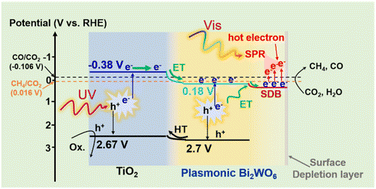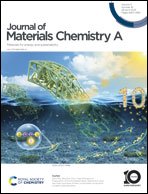Surface electron modulation of a plasmonic semiconductor for enhanced CO2 photoreduction†
Abstract
In plasmonic semiconductors, the presence of a surface depletion layer, where the electron density rapidly decreases, hinders their application in photocatalysis. Herein, plasmonic Bi2WO6 nanodots (BWO-NDs) with oxygen-vacancy-induced electron-trapping states were controllably grown on TiO2 nanosheets (TO-NSs) as plasmonic heterostructures for enhanced photocatalysis. UV-visible light-excited electrons on both TO-NSs and BWO-NDs were collected on the nanodots to modulate their surface electron density, leading to the strongest surface plasmon resonance (SPR) in 5 s. Moreover, the surface electron modulation broke the limitation of the surface depletion layer on hot electron generation of plasmonic BWO-NDs. Therefore, during the CO2 reduction reaction (CO2-RR), the optimal 15%-BWO-ND/TO-NS heterostructure generated 57.6 μmol g−1 methane with a selectivity of 75% in 3 h, which is over 12- and 5-fold higher than that of TO-NSs and plasmonic Bi2WO6, respectively. Moreover, the oxygen vacancies on the plasmonic BWO-NDs acted as active sites for CH4 generation. Our work provides an effective strategy to modulate the surface electron density of plasmonic semiconductors for enhanced photocatalysis.



 Please wait while we load your content...
Please wait while we load your content...